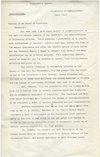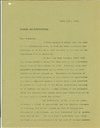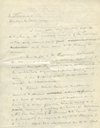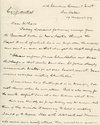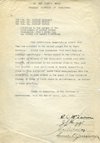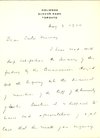“…for the good of the university” - 1919 Crisis
On 2 January 1919, Murray’s friend, University of Toronto president Robert Falconer, wrote advising him that he had submitted Murray’s name for consideration as president of the University of British Columbia. In his response, Murray seemed curiously uncertain of his status in Saskatchewan: “…unless the people here would prefer a change, I would prefer to stay. I am not sure whether they would prefer a change or not. If the question arises in a concrete form, I will make sure to that effect.” [Page 1 | Page 2]
Walter Murray may well have recognized that trouble was brewing. His report to Convocation on 1 May 1919 referred to the year just ending as the University’s “most trying.” The war, with its constant news of loss, had surely taken its toll; a final German initiative briefly called the hope of victory into question; then the influenza epidemic reached the city. [the 1918 flu epidemic: Page 1, Page 2, Page 3]
As Murray wrote, it had been “a session begun with foreboding, broken by the scourge of disease, thrown into disorder by the constant coming and going of students, crowded with feverish attempts to accomplish in three months the work of six or seven,” leaving Murray with “memories of work badly done and a sense of incompleteness.”(Annual Report, 1918-1919). There had been “trouble,” too, attempting to negotiate a site for the Normal School, which had wanted “more land on the University campus than we were willing to give.”
And faculty were increasingly under pressure. Salaries had not kept up with inflation, accelerated during the war. In two reports submitted by faculty in February 1918, they estimated the cost of living had risen by 70%, and requested an immediate increase of 33 ⅓%, “leaving the question of the permanent adjustment until a later date.” [Page 1, Page 2, Page 3, Page 4, Page 5] An interim solution, brought about by Murray, which gave faculty a “war bonus,” was not enough to stem some of the discontent. [Page 1 | Page 2] Additionally, some faculty were unhappy over the division of research grants.
Into this mix had been added something even less tangible, but nonetheless potentially more harmful: comments disparaging Murray and the administration of the University, made by senior faculty, to various members of the community in Saskatoon and elsewhere around the province. “For some time I have heard echoes of dissatisfaction on the part of certain members of the staff,” Murray wrote the Board. “Until recently I attributed it to legitimate difference of opinion. About a year ago…I began to suspect that some of the dissatisfaction had an ulterior purpose. This suspicion, however, seemed so unworthy and the purpose so unjust, that little serious attention was given to it.”
It all came to a head in March 1919, when Samuel Greenway, director of extension work for the University, went to Regina in hope of meeting with the Premier. Finding him absent, Greenway met instead with provincial treasurer CA Dunning. Greenway alleged three things: that Walter Murray had falsified a financial return to the legislature six years earlier; that Murray had misappropriated or “juggled” the University’s accounts; and that there was a widespread lack of confidence in his leadership among the faculty.
Any one of the charges Greenway had made was serious; if true, any one might have resulted in Murray’s dismissal as president. Combined, they were an extraordinary indictment, all the more so as Greenway sought to involve the government in the internal administrative affairs of the University and was specifically calling for an investigation.
As he testified later, Dunning was at a loss to know how to react. “Our University act is designed to keep the University out of politics,” he noted, and hoped Greenway would go to the Board with his allegations. While considering his options, however, more “rumours of trouble, … sort of street gossip” reached him, convincing Dunning that Greenway was not “the only one that was causing trouble, but that there was something going on.” During this interval a visit from another professor, J.L. Hogg, was not immediately understood by Dunning to be connected with Greenway. Hogg “seemed to me to be damning [Murray] with faint praise,” Dunning noted; “it struck me unfavorably that a man should speak so of his chief.” In a discussion of research and grants, Hogg also mentioned his colleague, R.D. MacLaurin. Some time later, when Greenway’s claims had been made public, Dunning saw MacLaurin at an unrelated event. “We wanted something started and you sure did it,” MacLaurin said. He was smiling.
Murray first learned of the allegations on 24 March 1919, when Dunning requested that Murray and Dean Rutherford meet with him in Regina. With Dunning’s agreement, Murray took immediate action to determine the validity of one of the accusations: that of non-confidence. He brought the question up in a Council meeting for a vote; then left. Two contentious meetings of University Council followed, on April 7 and April 9th. Notice was given for a motion of “confidence and loyalty to the President” to be voted on by calling of the roll. [Document]
Twenty-seven faculty voted for Murray and none against. Four abstained: J.M. Adams (Physics), J.L. Hogg (head of Physics), R.D. MacLaurin (head of Chemistry), and I.A. MacKay (Law). Greenway, out of town at the time, was not a member of Council, so would not have participated by vote directly in any event. Subsequent motions at the meeting enabled the four to present their reasons for abstaining as part of the minutes. They did not do so until 21 August, some 20 weeks later. A second motion made it clear the results were not intended to prejudice Greenway’s dispute.
J.M. Adams, offered headship of Physics at the University of California, resigned in June [Page 1, Page 2, Page 3]. Greenway, Hogg, MacKay and MacLaurin remained, and argued their differences with the president were matters of policy.
Murray, for one, certainly did not believe them. Shortly after the vote, Murray wrote Robert Falconer of Toronto. “As it appears to me,” he stated, “the personal factor has made it clear that it is not a question of difference of opinion on policy or administration, but something more disturbing than that, and therefore we cannot go on as we have in the past.” He noted Dunning had been “alarmed at what he thought was evidence of a conspiracy,” an impression, Murray stated, “in accordance with my own. For some time I have known that there has been an active propaganda on the part of certain members of the University, which has had the very definite object of bringing certain changes in the administration.” Although the Council vote “brought to a clear focus the centres of disaffection,” Murray felt an investigation would have to follow. “Whatever action is taken, the result will be very serious for some of us. I am prepared to accept full responsibility and to pay the price if necessary…the hand has been put to the plow, and one must follow in the furrow.”
Falconer responded quickly with his support, but agreed, “as you say it is now a case of either you or them. One University cannot hold both.” [Page 1, Page 2, Page 3]
In his draft letter of resignation to the Board, Murray acknowledged how personally he took the allegations against him. “Much as I resent the injustice of it all … I am forced, in order to save the University from serious injury, to tender my resignation of the office of President.…No other course seems open to me.”
Murray also noted the powers of the president in the appointment, promotion and dismissal of faculty, but suggested they were meant to “protect not to punish,” and that in particular, the president must “avoid even the suspicion of using his powers for his personal advantage or comfort. It is better to suffer than to do an injustice.” He also suggested the possibility of a leave of absence, during which time he might look for other employment.
The full Board met on 21 April, and after review of the situation, requested “each member of the University staff” submit a written statement indicating dissatisfaction, if any, with the administration of the University. Those with problems to report were invited to appear before the Board at its next meeting, on 2 May. Hogg and Greenway were specifically asked to appear at that meeting; MacKay and MacLaurin were invited both to submit in writing any specific issues they might have regarding the administration of the University, and to meet with the Board.
Greenway responded to both requests. In his written submission, he specifically cited faculty dissatisfaction with both Murray and Dean Rutherford. He nevertheless believed Murray’s statement to Council “conveyed a wrong impression,” and stated he had “no desire to embarrass the President….I took upon myself in a way which you may very properly regard as irregular, the responsibility of precipitating a crisis in the University Council” which might end “administrative methods which have bred suspicion and mistrust” and “free from narrow and stupid paternalism” his colleagues, whom he considered “capable and willing to assume their full share of responsibility…and a right to make their own mistakes.”
All members of the faculty with the exception of Hogg, MacKay and MacLaurin responded to the Board’s request for a written statement. None expressed any grievances of note. Hogg eventually appeared before the Board; MacKay eventually submitted a statement; MacLaurin claimed never to have received notice to do either.
The question of the accounting issues – both the alleged misinformation submitted in 1913, and the “juggling,” were dealt with fairly quickly. Neither was found to have any merit. The 1913 error, in fact, was proven to have originated with Greenway, who formally withdrew “any imputation of dishonesty” on Murray’s part – at least, before the Board. Murray wrote that he had “nothing further to say than that Mr. Greenway’s action in ignoring his responsibility to the Governors and going directly to the Government with his complaints was not due mainly to ignorance.” The “not” was added in by hand, but whether due to initial oversight or a later change of heart, is not clear.
The four men were given paid leaves from the University, after which point the Board indicated their resignations would be accepted. The four put their case before the public; as Clinkskill wrote Murray, about the outcome of a meeting at which the Board had outlined events and answered questions regarding the dismissal of the four faculty: “The ordeal is over. It was the most painful duty I have ever had in all my public life. …It seems to me they are preparing to get up some charge or charges either against the Board or the President. It matters not, the position we are in is unassailable and you need not worry over it. … You can rest satisfied that you possess the fullest confidence of every member of the Board and they will stand behind you till the last shot is fired. … Please do not cut your vacation short, take your time. Time will allow the flurry to subside.” [Page 1, Page 2, Page 3, Page 4]
But it did not. First came news of a significant health issue with Walter Murray “Today I received following message from the President’s brother in Nova Scotia…the message was sent in code so that it might be kept confidential ‘Please inform James Clinskill and Dean Rutherford that Doctor … strongly recommends Walter go at once health resort. Fears nervous collapse…’” Indeed, as events were to unfold, George Ling was named Acting President while Murray fought first, his ‘nervous collapse,’ then acute appendicitis.
The “four” were not willing to resign quietly; and as Jean Bayer noted to Murray, [Page 1, Page 2, Page 3, Page 4], they had convinced many that “it was an abstract principle they were fighting for.” Indeed, they were able to stir up enough public support that the Premier stepped in, trying to calm the waters; as did Murray’s many friends. Ten years to “the very week since the university began its instructional work,” Edmund Oliver spoke in support of Murray, noting the “five years of peace, five years of war” that had transpired. “The province has reason to be proud of the university. I know no other institution in Canada or elsewhere that has done so much under such circumstances…Let us beware here in Saskatoon lest we are too little appreciative of what has been accomplished. …And may I add as one of the oldest professors associated with the university…I want to say that while all have helped who have toiled together, yet I know whose dream it has been that has come true, whose sacrifice has contributed most to the splendid structure, and whose practiced hand has guided its course aright in the first formative, critical decade. That man has been Walter Murray. And Saskatchewan must not forget what it owes to such a man.”
The University Act enable the lieutenant-governor, as “University Visitor,” to investigate; the provincial legislature passed a bill enabling the Visitor to authorize the Court of King’s Bench to undertake investigations on his behalf: and so the matter was put before three judges.
Remarkably, toward the end of the investigation, all four men submitted to the court their resignations, in the event the outcome was found in their favour. That is: should the decision be against them, they would be dismissed; should it be for them, they would resign – perhaps a late attempt to signal the idealism of their cause. DocumentBut the judgment upheld the actions of the Board. All four men were dismissed; only Ira MacKay continued with an academic career (at McGill) – for which Walter Murray supplied him a letter of recommendation.
In early May 1920 Sir Joseph Flavelle wrote to Murray “with sincere regard”:
“I have read with deep satisfaction the summary of the finding by the Commissioners charged with the Enquiry into the dismissal of members of the staff of the University of Sask. …evidently the record was clear and the verdict clean. It has been a painful experience for you which has caused your admirers concern. I am pleased to know the agitation will now subside and you will be able to resume your work, freed from similar trying experience.
Murray’s response: “Our next difficulty is to forget and to try to think good things of all those concerned,and not bitter.” [Document]
There is still debate over the events of 1919: did the Board act precipitously in firing the four professors, or were Greenway, MacLaurin, Hogg and MacKay the authors of their own misfortune? Both sides could certainly have acted differently, perhaps ensuring different outcomes. WP Thompson, a member of faculty at the time and later to serve as the University’s third president, wrote 45 years after the events of 1919. He, and others on faculty at the time, were certain that Hogg had ambitions to replace Murray as president; and that all three – MacLaurin, Hogg and MacKay – believed Greenway’s charges and were unaware these had been shown false quite early on. “They intended to ‘bring out many things,’ to disparage the administration, to show themselves to be better men, but the collapse [of Greenway’s charges] made them pass to the defensive. … They were forced to deny that they had ever imputed wrongdoing or incompetence to the president, to minimize the differences between them and him as related only to minor matters of educational policy, not to administration and management.” Certainly it is evident no other member of faculty misunderstood what was at stake in the Council vote of confidence in Murray. But harm was done, quite specifically to the institution, which took some time to recover in public opinion. As Thompson noted, Murray’s “subsequent administration of seventeen years was characterized by great ability, vision, and resourcefulness. … Those seventeen years demonstrated what a great loss the university would have suffered, if the agitation against him had succeeded.” More importantly, perhaps, “It would, of course, have been a great personal tragedy. One of the finest, ablest, and kindest of men would have been disgraced.” (“A University in trouble,” Saskatchewan History, vol. XVII no. 3)

